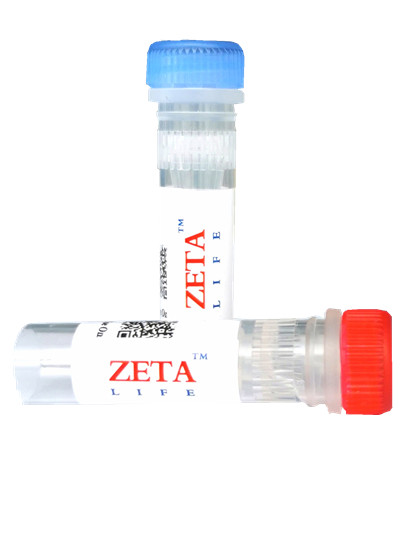

Reactive Oxygen Species Detection Kit
Packing specification
Product number: Ros100, Ros300, Ros500
Specifications: 100 times, 3 * 100 times, 5 * 100 times
Storage conditions
Store at 4oC, valid for one year; Store at -20oC, valid for two years;
Kit Contents:
|
Product ID |
Name |
Ros100 |
|
Ros100-1 |
H2DCFDA(10mM)in DMSO |
0.1mL |
|
Ros100-2 |
Reactive oxygen control(Rosup, 50mg/mL) |
1mL |
Introduction:
The Reactive Oxygen Species (ROS) Detection Kit provides the key reagents necessary for the detection of ROS in live cells. The assay is based on H2DCFDA, a reliable fluorogenic marker for ROS in live cells. We also provide the common inducer of ROS production Reactive oxygen control (Component B, Rosup), as a positive control. Using this combination of dyes according to the optimized protocol provided here, oxidatively stressed and nonstressed cells are reliably distinguished by fluorescence microscopy. Generation of ROS is inevitable for aerobic organisms, and, in healthy cells, occurs at a controlled rate. Under conditions of oxidative stress, ROS production is dramatically increased, resulting in subsequent alteration of membrane lipids, proteins, and nucleic acids. Oxidative damage of these biomolecules is associated with a variety of pathological events including atherosclerosis, carcinogenesis, ischemic reperfusion injury, neurodegenerative disorders and with aging.
We utilize H2DCFDA, a unique cell-permeable fluorogenic probe, compatible with phenol red, FBS and BSA to detect reactive oxygen species in live cells. Upon the cell entry, H2DCFDA is modified by cellular esterases to form a non-fluorescent H2DCF. Oxidation of H2DCF by intracellular ROS yields highly a fluorescent product that can be detected by FACS, microplate reader, or fluorescence microscope (Ex/Em 495/529 nm). The fluorescence intensity is proportional to the ROS levels. Our kit provides a simple and specific assay for the real-time measurement of global levels of ROS in living cells. We include sufficient reagents to perform 100 assays and a common ROS inducer as a control for measurement of ROS levels or antioxidant activity with high sensitivity, specificity and accuracy.
Materials Recommended but Not Provided:
Fluorescence microscope, Flow cytometer (FL-1 channel) and Microplate reader capable of measuring Ex/Em 495/529 nm spectra
Most live-cell buffering systems are suitable for the kit, the Hankʼs balanced salt solution (HBSS/Ca/Mg) is recommend.
Storage:
Component A: Store at -20°C protected from light, avoid multiple freeze/thaw cycles. Stable for12 months after received.
Component B: Store at -20°C protected from light. Warm to room temperature before use.
ROS Detection Assay Protocol:
The protocol was developed using live bovine pulmonary artery endothelial cells (BPAEC) and MRC5 human lung fibroblasts adhering to coverslips, but is amenable for use with other cell types. An additional protocol is provided for the use of (Component B, Rosup) as a positive control for the induction of ROS, which, if desired, must be performed before labeling with H2DCFDA.
1. Labeling with H2DCFDA
1.1 The Component A (H2DCFDA(10mM)in DMSO) is thoroughly thawed at room temperature (about 25°C)
1.2 Prepare 25 μM carboxy-H2DCFDA working solution. Add 5.0 μL of the 10 mM H2DCFDA stock solution (prepared in step 1.1) to 2.0 mL of warm HBSS/Ca/Mg or other suitable buffer.
1.3 Wash cells. Gently wash cells once with warm HBSS/Ca/Mg or other suitable buffer.
1.4 Label cells. Apply a sufficient amount of the 25 μM H2DCFDA working solution (prepared in step 1.2) to cover the cells adhering to the coverslip(s). Incubate for 30 minutes at 37°C, protected from light.
1.5 Wash cells. Gently wash the coverslips three times in warm HBSS/Ca/Mg or other suitable buffer.
1.6 Mount in warm buffer and image immediately. Best results are obtained when imaging takes place immediately after washing and mounting the sample.
2. Induction of Cellular ROS Production with Component B(Rosup):
2.1 Make 100 μM working solution of Rosup.
Dilute the Component B 1:5000 in appropriate complete growth media to produce a 100 μM working solution. For example, add 1μL Component B to 5 mL of complete media. to make 5.0 mL of 100 μM Rosup working solution,
2.2 Induce ROS production in cells. Apply a sufficient amount of the 100 μM Rosup working solution (prepared in step 2.1) to the cells adhering to the coverslip(s). Incubate the coverslip(s)at 37°C and 5% CO2. During development of the product using BPAE and MRC5 cells, a 60–90 minute incubation period was required. Appropriate incubation periods for ROS production in other cell lines should be determined empirically. After induction, label the cells with H2DCFDA starting with step 1.1, above
2.3 Wash cells. Gently wash the coverslips twice in warm HBSS/ Ca/Mg or other suitable buffer. After washing, label the cells with H2DCFDA starting with step 1.1, above.


